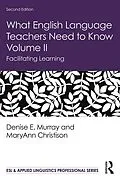Designed for pre-service and novice teachers in ELT, What English Language Teachers Need to Know Volumes I, II, and III are companion textbooks organized around the key question: What do teachers need to know and be able to do in order to help their students to learn English?
In the Second Edition of Volume II, Murray and Christison return to this essential question and cover the three main facets of teaching: planning, instructing, and assessing L2 English instruction. Addressing new skills and strategies that ESL and EFL teachers require to meet the needs of their shifting student populations who are impacted by changing demographics, different learning contexts, and digital environments, this book offers a strong emphasis on practical applications for classroom teaching that is grounded in current research.
This updated and expanded Second Edition features:
- a new section on teacher learning, including a chapter on exploring digital technologies in ELT
- new and updated classroom examples throughout
- discussions of how teachers can prepare for contemporary challenges, such as population mobility and globalization.
The comprehensive texts work for teachers across different contexts-where English is the dominant language, an official language, or a foreign language; for different levels-elementary/primary, secondary, university, or adult education; and for different learning purposes-general English, workplace English, English for academic purposes, or English for specific purposes.
Autorentext
Denise E. Murray is Professor Emeritus at Macquarie University, Australia, and Professor Emeritus at San José State University, USA.
MaryAnn Christison is a Professor in the Department of Linguistics at the University of Utah, USA.
Klappentext
Designed for pre-service teachers and teachers new to the field of ELT, Volume II of the What English Language Teachers Need to Know set covers the three main facets of teaching: planning, instructing, and assessing. Updated with new research throughout, the focus throughout is on outcomes, that is, student learning. The texts work for teachers across different contexts; different levels, and different learning purposes. The Second Edition has expanded to address corpus-based data, new technologies, and a wider range of contexts.
Inhalt
PART I: Planning for Learning
1. Planning Curriculum
2. Planning Lesson Content
3. Planning Activities and Managing Classroom Interaction
4. Selecting and Adapting Materials
PART II: Instructing for Learning
5. Teaching Young Learners
6. Teaching Adolescent Learners
7. Adult Immigrants and Refugees
8. Postsecondary Adult Learners
9. Workplace Literacy
10. Integrating Language and Content
PART III: Assessing for Learning
11. Classroom-based Assessment
12. Large-Scale Assessment
13. Program Evaluation
PART IV: Continuing Teacher Learning
14. Exploring One's Own Instruction
15. Exploring the Use of Digital Technologies in English Language Teaching
